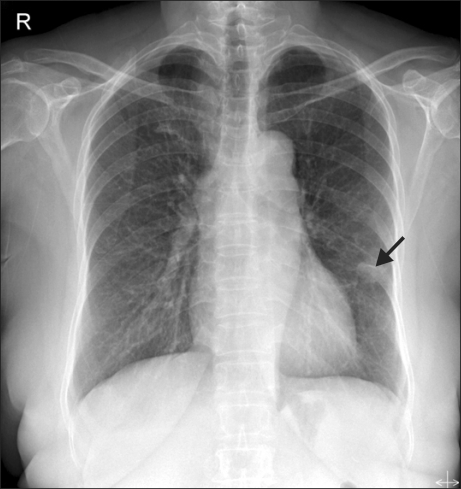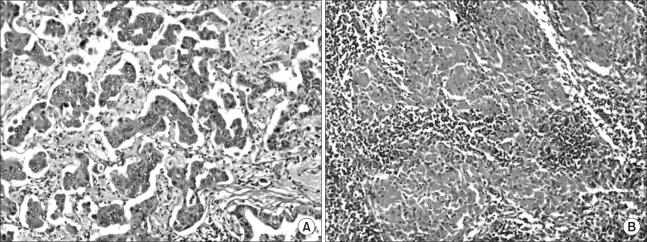Abstract
Sarcoidosis is a somewhat common pulmonary disease, but the concurrence of lung cancer and sarcoidosis in the same patient is very rare. Because sarcoidosis usually presents as mediastinal lymphadenopathies, this concurrence in a lung cancer patient detected radiologically is apt to be misunderstood to be mediastinal metastases, and it is thus considered to be an unresectable disease. We report a case of lung cancer associated with sarcoidosis that developed in a 65-year-old woman who underwent surgery. Radiological studies revealed a 1.9×1.7 cm mass in the left upper lobe with multiple enlarged bilateral mediastinal lymph nodes (2R, 3a, 4R, 4L, 5, 6, 7, 8R). Pathologic findings showed that the mass was a well-differentiated adenocarcinoma and all of the enlarged mediastinal lymph nodes were granulomas without cancer metastasis. We report this case with a review of the literature.
Keywords: Cancer, Sarcoidosis
CASE REPORT
A 65-year-old woman who had had a chronic cough for 4 years and follow-up in the pulmonary department was incidentally discovered to have a mass in the left upper lobe of the lung on a simple chest x-ray (Fig. 1). Her vital signs at admission were normal and laboratory results were WBC 4,290/mm3, hemoglobin 12.5 g/dL, hematocrit 37.2%, platelet 172 k/mm3, ESR 7 mm/h, and CEA (carcinoembryonic antigen) 0.86 ng/mL. A serology test and culture for mycoplasma, chlamydia, and tuberculosis were all negative. Chest computed tomography and PET-CT showed a 1.9×1.7 cm mass in the left upper lobe and suspicious metastatic lymph nodes in multiple bilateral mediastinal lymph nodes (2R, 3a, 4R, 4L, 5, 6, 7, 8R) (Fig. 2). Bronchoscopic findings were non-specific and PCNA (percutaneous needle aspiration) of the mass under chest CT revealed adenocarcinoma. At first we considered it an unresectable lung cancer with contralateral metastatic mediastinal lymph nodes (N3). We biopsied the right paratracheal lymph nodes (2R, 4R) under mediastinoscopy and the pathology reports showed that they were benign and non-caseous granuloma. We chose to operate and performed a thoracotomy for a left upper lobectomy and mediastinal lymph node dissection. After the operation, the pathology report showed that the mass was adenocarcinoma and there was no cancer metastasis in the dissected lymph nodes with the exception of noncaseating epithelioid cell granuloma (Fig. 3) that was consistent with sarcoidosis. The tuberculosis polymerase chain reaction (Tb-PCR) test from the specimens was negative. The stage was estimated to be IB (T2N0M0). The patient was discharged on the sixth postoperative day without any complications.
Fig. 1.
A simple chest X-ray shows a 1.9×1.7 cm hyperdense, ovoid lesion in the lingual segment (arrow).
Fig. 2.
Chest CT (A) and PET-CT (B, C) show a suspicious malignant tumor in the lingular segment and multiple bilateral mediastinal lymph node metastases.
Fig. 3.
Pathologic appearance of the resected specimen. (A) Lung tumor: a well-differentiated adenocarcinoma was found. (B) Lymph node: a noncaseating epithelioid cell granuloma but no cancer metastasis was observed (H&E stain, ×200).
DISCUSSION
Curative resection for lung cancer is difficult when the cancer has metastasized to the mediastinal lymph nodes. To determine the optimal treatment strategy, especially indications for surgery, mediastinal lymph nodes must be evaluated pathologically before the operation. There are many reasons why mediastinal lymphadenopathy may look like cancer metastases radiologically, and one of them is sarcoidosis [1].
Sarcoidosis is a systemic granulomatous disease of unknown etiology that mainly develops between 25 and 40 years of age and primarily affects the lungs and the lymphatic system [1,2]. The generally accepted pathogenic hypothesis is that certain environmental factors could promote sarcoidosis in genetically susceptible hosts [2]. The characteristic lesion of sarcoidosis is a noncaseating granuloma that consists of epithelioid cells and T lymphocytes [2]. Diverse clinical courses are observed according to the epidemiologic factors, involved organs, and disease severity [2]. Spontaneous remissions occur in about two thirds of patients, but the clinical course is chronic or progressive in 10 to 30%. Mortality, ranging between 1 and 5%, is mostly related to progressive respiratory failure, the central nervous system, or myocardial involvement [2,3]. The mainstay of treatment for sarcoidosis is systemic corticosteroid administration [2]. However, the indication, optimal dose, and duration of corticosteroid therapy continue to be controversial [1,2].
The association of sarcoidosis with malignancy has been published in several studies with conflicting results, due to the clinical and radiographic features of the disease, which may be similar to malignancies such as lymphoma or lung cancer, sometimes lacking histologic confirmation [4,5]. The relationship between sarcoidosis and lung cancer has been published in several studies. Brincker and Wilbek studied 2,544 patients and found that lung cancer occurred 3 times more frequently in patients with sarcoidosis [5,6], but the exact relationship between sarcoidosis and lung cancer is still unclear [5]. Sakula presented 3 possibilities: (1) sarcoidosis develops before the development of the lung cancer, and is more or less related and may even induce the malignant change; (2) sarcoidosis develops as a reaction to the lung cancer; (3) sarcoidosis develops before the development of the lung cancer, the occurrence of the lung cancer and sarcoidosis being completely coincidental [7]. Sakula's 1st type is represented by cancer that develops from postinflammatory scar tissue, in other words, scar cancer. The 2nd type is difficult to apply because one cannot know exactly when sarcoidosis developed before it is clinically apparent [6]. In our case, sarcoidosis and lung cancer occurred simultaneously, there was no sarcoidosis in the lung mass and no scar lesion. This case was the 3rd of Sakula's types. Despite there currently being conclusive evidence, sarcoidosis is suggested to have no influence on the prognosis of such patients [3,6]. Several cases with concurrent sarcoidosis and lung cancer have been reported. In most of these cases, sarcoidosis existed for multiple years before the development of lung cancer. Simultaneous diagnosis of both diseases, as in our case, is rarer.
We found and treated the patient with coincidence of sarcoidosis and lung cancer successfully.
References
- 1.McNeill M, Zanders TB, Morris MJ. A 49-year-old man with concurrent diagnoses of lung cancer, sarcoidosis, and multiple regions of adenopathy on positron emission tomography. Chest. 2009;135:546–549. doi: 10.1378/chest.08-1221. [DOI] [PubMed] [Google Scholar]
- 2.Wu JJ, Schiff KR. Sarcoidosis. Am Fam Physician. 2004;70:312–322. [PubMed] [Google Scholar]
- 3.Tomimaru Y, Higashiyama M, Okami J, et al. Surgical results of lung cancer with sarcoid reaction in regional lymph nodes. Jpn J Clin Oncol. 2007;37:90–95. doi: 10.1093/jjco/hyl141. [DOI] [PubMed] [Google Scholar]
- 4.Sato Y, Sasano S, Oyama K, Sakuraba M, Onuki T, Nitta S. Lung cancer associated with sarcoidosis. Jpn J Thorac Cardiovasc Surg. 2003;51:21–24. doi: 10.1007/s11748-003-0061-0. [DOI] [PubMed] [Google Scholar]
- 5.Bouros D, Hatzakis K, Labrakis H, Zeibecoglou K. Association of malignancy with diseases causing interstitial pulmonary changes. Chest. 2002;121:1278–1289. doi: 10.1378/chest.121.4.1278. [DOI] [PubMed] [Google Scholar]
- 6.Yamasawa H, Ishii Y, Kitamura S. Concurrence of sarcoidosis and lung cancer. A report of four cases. Respiration. 2000;67:90–93. doi: 10.1159/000029470. [DOI] [PubMed] [Google Scholar]
- 7.Sakula A. Bronchial carcinoma and sarcoidosis. Br J Cancer. 1963;17:206–212. doi: 10.1038/bjc.1963.29. [DOI] [PMC free article] [PubMed] [Google Scholar]





